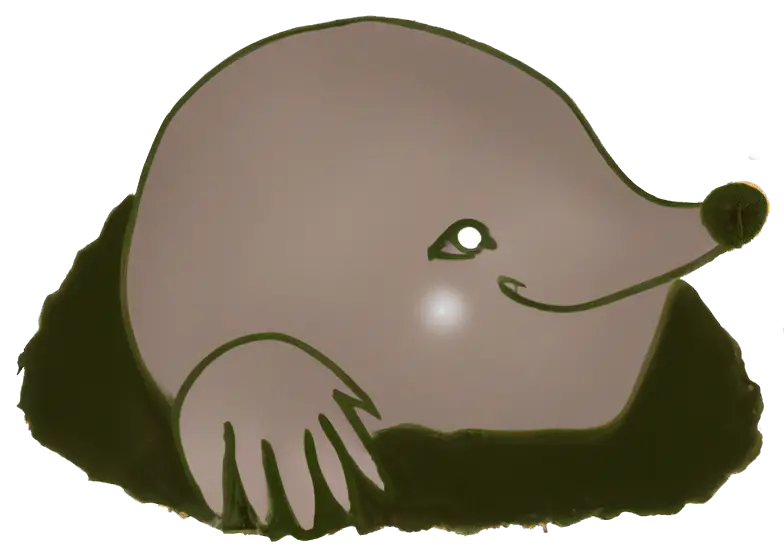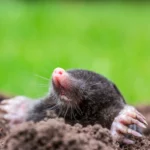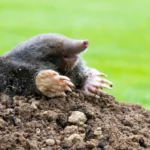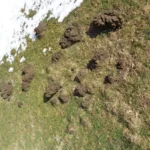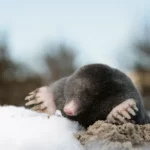The world of small mammals can be quite confusing, especially when it comes to identifying the differences between closely related species like moles and voles. Both creatures burrow tunnels and can cause problems for gardeners and farmers alike. However, despite being similar in some ways, these little creatures have distinct physical characteristics that set them apart. In this article, we will explore the unique traits of both moles and voles, highlighting their key differences in fur and coloration, body shape and size, claws, teeth, and their eyes and ears. By the end, you will be able to tell apart these two species with ease.
Mole Physical Characteristics
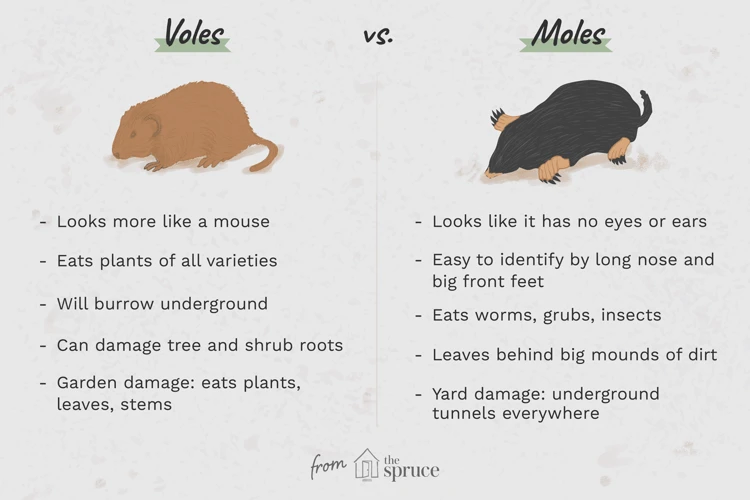
Moles are fascinating creatures that belong to the family Talpidae. They are well-known for their peculiar underground lifestyle and diverse physical characteristics. These underground mammals come in different sizes and shapes with unique features that enable them to excel in their subterranean habitats. In this section, we will delve into the physical characteristics of moles, including their fur and coloration, body shape and size, claws, eyes, and ears. Understanding these features will help us appreciate how moles have adapted to life underground. To begin, let’s take a look at their fur and coloration, which can be found in more detail in this article.
Fur and Coloration
When it comes to physical characteristics, both moles and voles have their unique features that set them apart. One of the distinguishing features is their fur and coloration.
Moles: Moles have a characteristic black or dark brown coat that is thick, soft, and velvety to the touch. The fur is specialized for a subterranean lifestyle, and it is denser than any other mammal, consisting of over 1,000 hairs per square inch. Interestingly, moles are not able to see well, and their senses of smell and touch play vital roles in underground life. Some species of moles, such as the star-nosed mole, have a distinctive ring of pink, fleshy tentacles around their snouts that they use to feel around for prey.
Voles: Voles have brown, gray, or reddish-brown fur covering their bodies. Their fur is not specialized for subterranean life and is shorter and coarser than that of moles. Unlike moles, voles have good eyesight and can see well in daylight. They also have small, rounded ears that are visible on the top of their heads, which is not the case for moles.
While both moles and voles share some similarities in their physical characteristics, they also have some significant differences, particularly in their fur and coloration. The following table summarizes the differences in moles and voles’ fur and coloration:
| Moles | Voles | |
|---|---|---|
| Fur | Thick, soft, velvety, specialized for subterranean life, black or dark brown | Shorter, coarser, not specialized for subterranean life, brown, gray, or reddish-brown |
| Coloration | Black or dark brown | Brown, gray, or reddish-brown |
| Ears | Small and not visible | Small and visible on top of their heads |
| Senses | Reliant on senses of smell and touch due to poor eyesight | Good eyesight, and sense of smell |
Learn more about mole’s traits here.
Body Shape and Size
The body shape and size of mole and vole are two of the most noticeable differences between these two animals. Moles are generally larger and heavier than voles. On average, a mole can grow up to 6-7 inches long and weigh between 2.5-4.5 ounces. In contrast, voles are much smaller, with an average size of 4-5 inches and a weight of around 1 ounce.
One of the most notable features of a mole’s body is its elongated snout which is used for digging. Their bodies are designed for underground existence and are perfectly suited for burrowing through soil. Moles have broad, powerful shoulders and large forearms with strong claws. These features help them to dig and move through the soil with speed and agility. Moles have a streamlined body that is ideal for maneuvering through tight spaces underground.
On the other hand, voles have a more rounded and compact body shape. Their bodies are not designed for digging and burrowing like moles. Instead, they spend their time on the surface of the ground, mostly hiding in grassy areas. Voles have shorter legs and smaller feet with less prominent claws. This body shape is more suitable for running and hopping over vegetation.
| Moles | Voles | |
|---|---|---|
| Average Size | 6-7 inches long | 4-5 inches long |
| Average Weight | 2.5-4.5 ounces | 1 ounce |
| Body Shape | Streamlined, elongated snout for digging, broad shoulders and forearms. | Rounded, not designed for digging, short legs and smaller feet. |
| Digging Ability | Expert diggers, powerful claws, ideal for burrowing through soil. | Not designed for digging, spends time on the surface of the ground. |
The body shape and size are significant characteristics that differentiate moles and voles. While moles are larger, heavier, and are experts at digging through soil, voles have a more compact, rounded shape, and spend their time on the surface of the ground.
Claws
The claws of moles are specially adapted for digging underground. They are wide and flat with sharp edges, and they are positioned in such a way that the mole can use them like shovels to move soil out of its path. The front paws of moles have five toes, each ending in a claw, while the hind paws have only four toes.
The shape and size of the claws vary depending on the species of mole. For instance, the star-nosed mole has larger claws than other mole species, which are ideal for digging in swampy areas. The claws of the Eastern mole species are smaller, but they are still powerful enough to help the animal move through the soil.
It is interesting to note that the star-nosed mole has a unique adaptation in its claws. This mole has sensory receptors in its claws that enable it to feel its way through the soil. This adaptation is essential for this mole, which lives in areas with little or no visibility.
Here is a table summarizing the information about mole claws:
| Characteristic | Description |
|---|---|
| Shape | Wide and flat with sharp edges |
| Position | Positioned in a way that moles can use them like shovels to move soil out of their path |
| Number of toes | Front paws have five toes while the hind paws have four toes |
| Size | Varies depending on the species of mole with the star-nosed mole having the largest ones |
| Unique adaptation | Star-nosed mole has sensory receptors in its claws that enable it to feel its way through the soil |
To learn more about star-nosed mole’s uncommon physical traits, read our article about star-nosed mole physique.
Eyes and Ears
When it comes to the physical characteristics of moles and voles, one of the areas that sets them apart is their eyes and ears.
Moles:
Moles have very small eyes and ears, which are often concealed within their thick fur. Their eyes are tiny, and they can barely see anything beyond light and dark. They mainly rely on their sense of touch and smell to navigate their environment. Moles have a keen sense of smell, as their noses are highly sensitive to the presence of prey such as insects, worms and larvae.
Voles:
In contrast, voles have larger eyes and ears in proportion to their body size. They have large, round eyes that provide them with excellent vision, allowing them to navigate quickly and spot predators from a distance. Their ears are also larger, which means they have a more developed sense of hearing, allowing them to detect predators approaching or communicate with other voles.
To summarize their differences in eyes and ears, moles have small eyes and ears that are concealed within their fur, while voles have larger, more prominent eyes and ears that help them navigate and communicate with others in their environment.
To make it more comprehensible, here is an HTML table:
| Eyes | Ears | |
|---|---|---|
| Moles | Small and concealed within fur | Small and concealed within fur |
| Voles | Larger and more prominent | Larger and more developed |
Vole Physical Characteristics
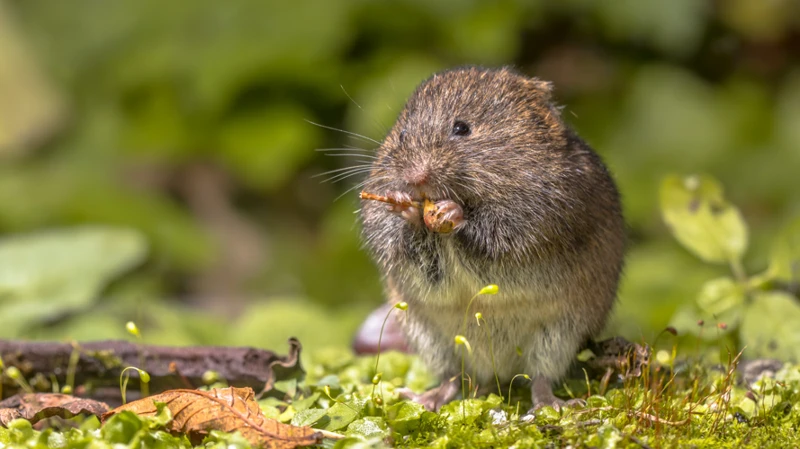
As we move on to discussing the physical characteristics of voles, it’s important to note that although they may be similar in appearance to moles at first glance, they are actually quite distinct in several ways. From their unique body shape to specialized teeth, voles have certain physical traits that help them thrive in their natural habitats. Let’s take a closer look.
Fur and Coloration
One of the most obvious differences between moles and voles is their fur and coloration. Moles have short, velvet-like fur that is typically black, brown, or gray. This soft fur lies in all directions, which helps the mole to move easily through the soil without creating too much resistance.
On the other hand, voles have a longer, denser fur that can range from gray to reddish-brown. The fur on voles is also more uniform in direction, which means it can become matted and tangled more easily.
To summarize, moles and voles have different types of fur and coloration as shown in the following table:
| Mole | Vole | |
|---|---|---|
| Fur | Short, velvet-like | Long, dense |
| Coloration | Black, brown, or gray | Gray to reddish-brown |
Differences in fur and coloration can make it easier to distinguish between moles and voles.
Body Shape and Size
When it comes to body shape and size, moles and voles differ significantly. While moles have a cylindrical-shaped body, voles have a more elongated body shape that resembles that of a mouse. Additionally, voles are usually smaller than moles.
To help visualize the differences in body shape and size, the following table compares the physical characteristics of moles and voles:
| Moles | Voles | |
|---|---|---|
| Body Shape | Cylindrical | Elongated (resembles mouse) |
| Body Size | 4-9 inches (10-23cm) | 3-7 inches (7-18cm) |
As you can see, moles have a more uniform cylindrical body shape, while voles’ bodies are longer and resemble those of mice. Additionally, moles tend to be slightly larger than voles, measuring between 4-9 inches (10-23cm) in length, while voles measure between 3-7 inches (7-18cm) in length. However, it’s worth noting that there are various species of both moles and voles, and their body sizes can vary depending on the species.
Teeth
Voles have different teeth from moles. They are specialized for gnawing on vegetation, and this is reflected in their dental characteristics. Their front incisors, which are the ones visible outside of the mouth, are large and have a hard, yellow enamel layer on the front surface to protect it from wear and tear as they gnaw on plants. In comparison, moles’ incisors are smaller and less noticeable.
Additionally, voles have teeth that continue to grow throughout their life, due to the excessive wear caused by their gnawing activities. They have molars and premolars with deep, sharp cusps that help them grind plant material. This is different from the dental structure of moles, as they have fewer teeth than voles, and their molars and premolars have flatter surfaces that are designed for crushing and grinding soil to extract small insect prey.
The following table summarizes the differences between the teeth of moles and voles:
| Moles | Voles | |
|---|---|---|
| Incisors | Smaller and less noticeable | Large, with hard enamel layer on front surface |
| Molars and Premolars | Flatter surface for crushing and grinding soil | Deep, sharp cusps for grinding plant material |
| Growth of Teeth | Stops growing after reaching adult size | Continues to grow throughout life |
In addition to the differences summarized in the table, vole teeth are also softer than those of moles, as their diet is less abrasive. This makes their teeth wear down more quickly than those of moles, which is why they grow continuously.
The dental characteristics of moles and voles reflect their different diets and ways of life. The differences between their teeth are just one example of the many physical characteristics that set these two animals apart from each other.
Eyes and Ears
When it comes to their eyes and ears, moles and voles have some distinct differences that set them apart from each other.
Moles have small, beady eyes that are often hidden behind fur, and they are not well-developed because they rely more on their other senses such as touch and smell to navigate and find prey. Their ears are also small and not visible on the surface, as they are covered with fur to protect them from dirt while burrowing.
On the other hand, voles have larger eyes and ears that are visible on the surface. Their eyes are positioned on the sides of their head which allow them to have a wider field of vision to detect predators, while their large ears help them to hear any potential danger.
Here is a table summarizing the differences between the eyes and ears of moles and voles:
| Moles | Voles | |
|---|---|---|
| Eyes | Small and hidden behind fur | Larger and visible on surface |
| Ears | Small and not visible on surface, covered with fur | Larger and visible on surface, help them hear potential danger |
While both moles and voles are experts at living underground, they have some significant differences when it comes to their eyes and ears. These differences play an essential role in how they navigate and find their way while underground, as well as how they detect potential threats from predators.
Comparison Chart
When it comes to distinguishing between moles and voles, a comparison chart can be incredibly helpful. Here’s a breakdown of some of the key physical characteristics of each animal:
Fur: Moles have a velvety fur that is typically dark brown or black in color, while voles have softer fur that can vary in color from dark brown to grayish-brown.
Body Shape and Size: Moles have a stocky, cylindrical body that can range in length from 4-8 inches, while voles are more slender and can grow up to 7 inches long.
Claws vs Teeth: Moles have large front claws that are well-suited for digging, while voles have sharp front incisors that they use to gnaw on vegetation.
Eyes and Ears: Moles have very small eyes that are often covered by fur, as well as tiny, almost vestigial ears that don’t function well. Voles, on the other hand, have larger eyes and ears that are more visible.
While there are some similarities between moles and voles, such as their fur and body shape, there are some key differences that set them apart. By looking at a comparison chart, you can easily see these differences and use them to identify which animal you’re dealing with.
Conclusion
After scrutinizing the physical characteristics of moles and voles, it is evident that these two burrowing mammals differ significantly in their appearance. Moles are covered in dense, short, velvety fur that varies in color from dark brown to grey, while voles have softer and longer fur that ranges from brown to reddish-brown.
In addition to their different fur and coloration, moles have a cylindrical and stocky body, tiny eyes, and ears that are not visible. Moles also have large, powerful front paws with claws specifically adapted for digging. Voles, on the other hand, have a more oblong and compact body shape, visible eyes and ears, and prominent incisor teeth that enable them to gnaw on vegetation.
The dissimilarities in physical traits of moles and voles make them easy to distinguish from one another. Although they may have a comparable role in the ecosystem, moles and voles live in different niches and habitats, and they have different behaviors and diets.
Overall, moles and voles may have a few similarities, but it is their distinctions that set them apart. Through exploring the physical characteristics of these animals, we not only learn more about them individually but also understand the ecological roles they play in our environment.
Frequently Asked Questions
What is the main difference between moles and voles?
The main difference between moles and voles is that moles are burrowing mammals while voles are not. Moles have adapted for digging and tunnelling underground, while voles live in above-ground burrows.
What is the average size of a mole?
The average length of a mole is approximately 6 inches (15cm), although some species can grow up to 9 inches (23 cm) in length.
Which species of mole has no eyes?
The star-nosed mole is the only species of mole that has no visible eyes. Instead, they use their unique appendages on their snout to navigate and find food.
What color is a typical mole?
Most moles have dark fur that ranges from dark brown to black. This coloration helps them blend in with the soil in which they dig.
Are voles herbivores or carnivores?
Most voles are herbivores, feeding on seeds, grasses, and other plant material. However, some species do eat insects and other small animals.
What is the average lifespan of a vole?
The average lifespan of a vole is around 3-6 months, although some species can live up to 2 years in the wild.
Do voles hibernate during the winter months?
No, most voles do not hibernate during the winter months. Instead, they rely on caches of stored food to survive the colder temperatures.
What is the purpose of a mole’s specialized claws?
Moles have specialized claws that are adapted for digging tunnels underground. These powerful claws can even move through soil in a swimming motion.
How do voles protect themselves from predators?
Voles protect themselves from predators by using their burrows as a form of shelter. They also have the ability to reproduce rapidly, ensuring that their population does not decline too much from predators.
What is the main threat to mole and vole populations?
The main threat to mole and vole populations is habitat loss due to human activity. Urbanization and agricultural development can destroy the burrows and habitat that these creatures rely on for survival.
